
Construction | Marketing | 06.18.2018
8 Ways to Increase Construction Website Leads
Is your construction company’s website generating leads for you? Do you have new clients reaching out to your regularly through your website for project proposals and construction estimates?
Getting new leads for your business, whether you’re a solo contractor or a major construction company, is crucial. Leads are the lifeblood of your business.
[blog_callout text=”Leads are the lifeblood of your business”]
Below I’ve outlined 8 of the best ways to get construction leads from your company website.
[blog_toc]
Tip #1: Make Sure it’s Easy for Prospects to Contact You
Tip #2: Make Sure Your Website Is Serviceable
Tip #3: Build Credibility
Tip #4: Have Clear Service Pages
Tip #5: Don’t Go Cheap on Photos
Tip #6: Be a Thought Leader
Tip #7: Choose Your Niche
Tip #8: Talk About the “How”
Conclusion
[/blog_toc]
Tip #1: Make Sure it’s Easy for Prospects to Contact You
Your Phone Number
This may seem like a no-brainer, but it’s always amazing how many companies don’t post their phone number in an easy to locate position. Usually, the top right corner on your website header works best. I would also suggest that the phone number be text-based instead of image-based. Images are hard for a search engine to decipher and users may be browsing from their phones. If your phone number is image-based, they won’t be able to “click to call”.
A Contact Form
Contact forms are nice because you’re not posting an email address that will result in a lot of spam. Perhaps more importantly though, contact forms allow you to guide the conversation with your prospective client. You can ask for specific information such as the prospects full name, their address, company and phone number. You can also put subject line options so the user can tell you the purpose for their message.
[blog_callout text=”Contact forms allow you to guide the conversation with your prospective client.”]
Here’s a screenshot from a sample contact form:
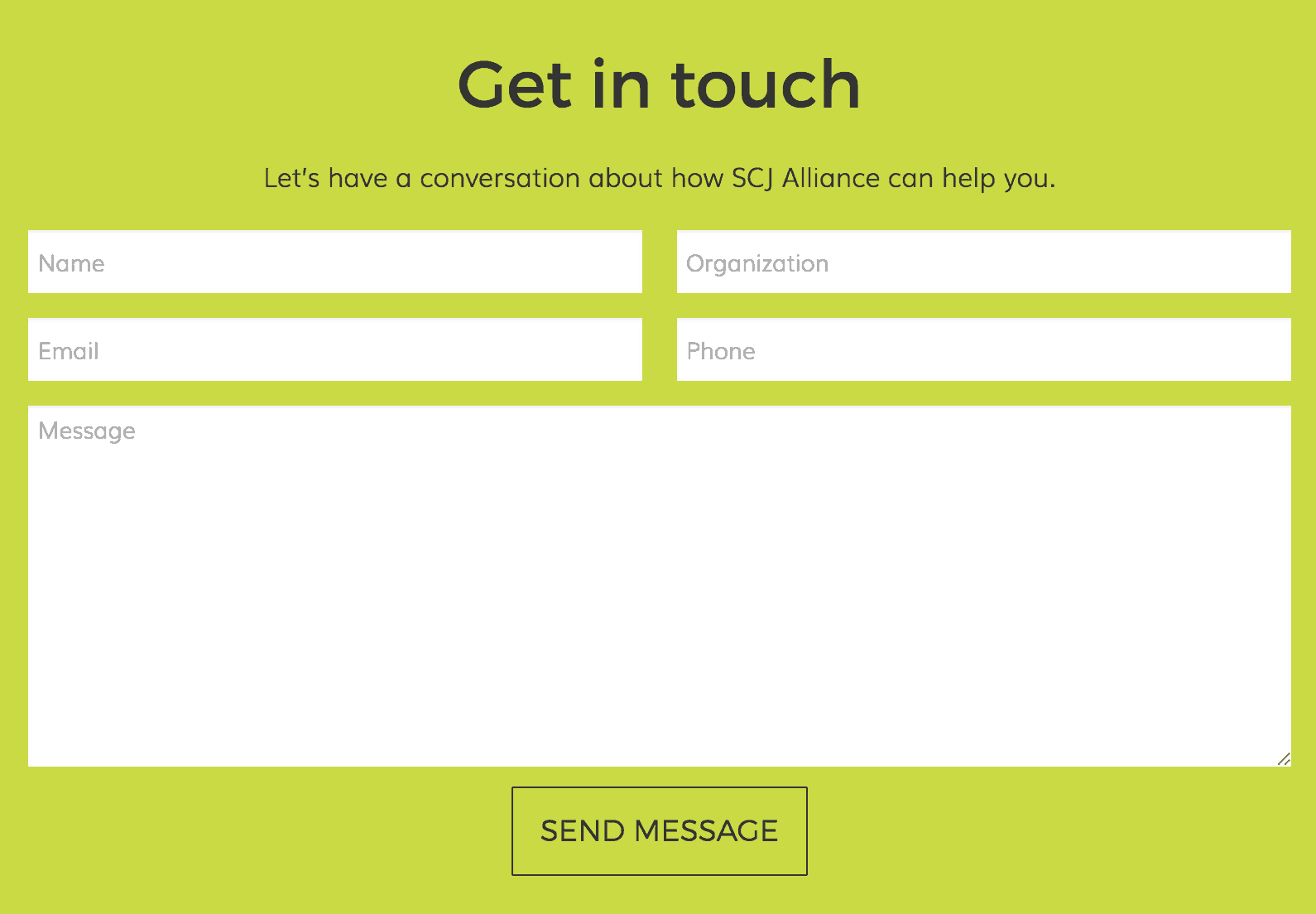
Request a Quote or Estimate Form
Additionally, another big contact option that construction companies should consider is a “Request a Quote” form. Much like a general contact form, this form can be highly guided, ensuring that you get all of the information that you need from your prospect. These forms can include fields such as:
- Full name
- Company
- Title
- Phone number, city, state
- Timeline
- Budget (usually a drop down)
- Project notes
- RFP file upload
Here’s an example request a quote form:
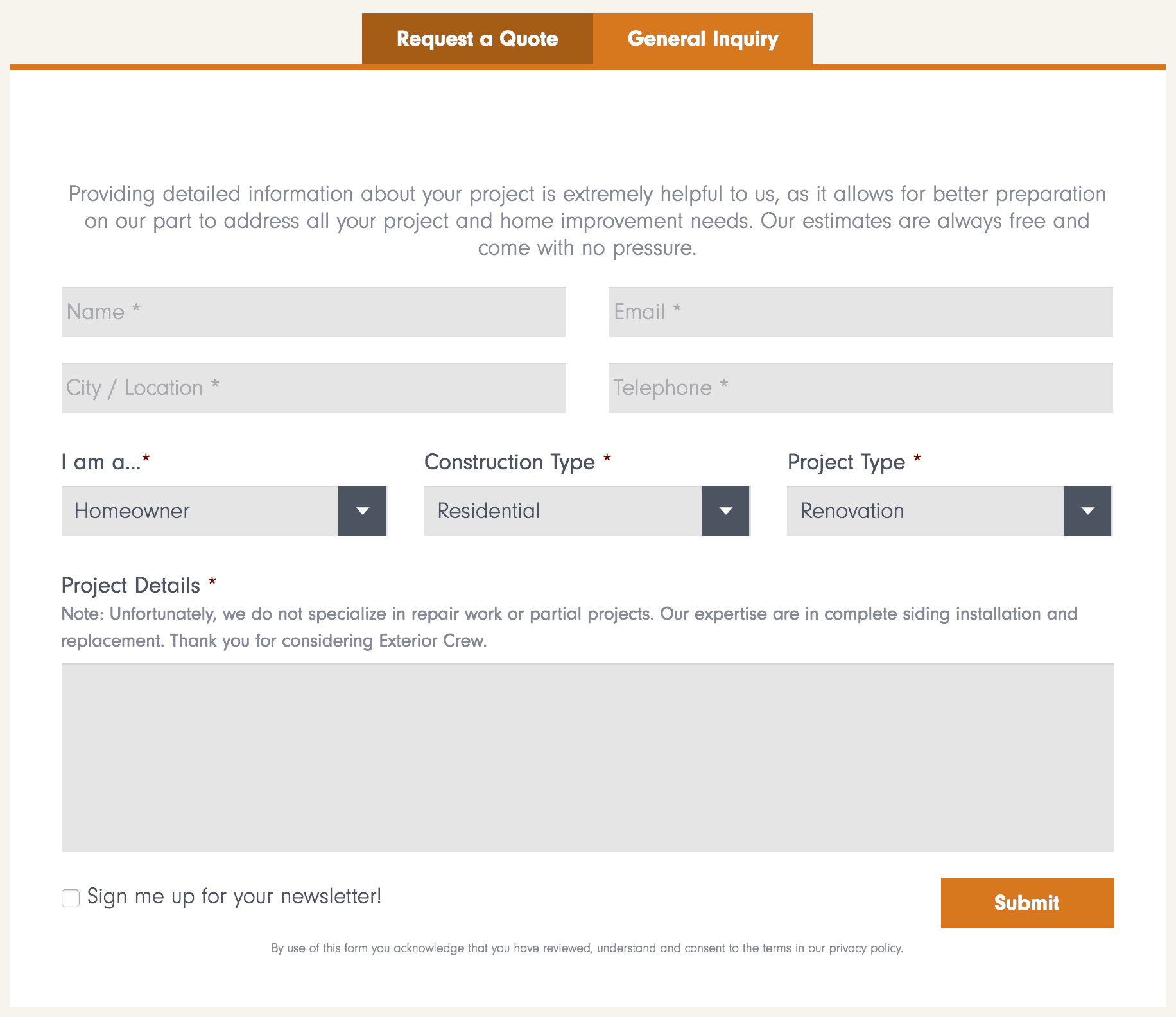
Placement Considerations
As I mentioned above, make sure to put your phone number in an easy-to-find place on your website. Along with this, you might also want to consider placing a “Request a Quote” button directly in a prominent place (i.e. your header) as well to encourage folks to reach out. If you’re able to provide free estimates or consultations, you may find the word “FREE” increases your conversion rates.
Tip #2: Make Sure Your Website Is Serviceable
When it comes to leads, a big question you need to ask is whether or not your current website is actually serviceable. If your website isn’t at par with your competition, you may find that all of your work to increase lead volume is in vain. Bottom line: your website may not look very credible.
Is Your Website Older?
If your website is 5 or more years old, you might want to consider a revamp. If the website still looks and functions nicely, you may be able to get away with keeping it for another year or two, but make sure to get feedback from outsiders. If outsiders think that your website feels old and neglected, make sure to pause.
One problem in particular with older websites is that most of them aren’t built responsively. Essentially, what this means is that the website isn’t mobile-friendly. If that’s the circumstance that you’re in, you might want to consider a new website for that reason alone.
Does Your Website have Bugs or Issues?
Another consideration is the functionality on your construction website. Are your pages loading properly? Does your website load quickly? Do your forms work? Do you have any 404 pages (‘page not found’)? Here’s a link to a more exhaustive list…
If there are issues with your website that are keeping it from working properly, in general, you’re going to see a reduction in conversions and leads.
Is Your Website Attractive & Professional?
Your website aesthetics speak more for your company than you might think. When a website is old or dated, it’s very easy for prospective clients to project the attributes of your website onto your company. In the same way that physical elements at your actual office can be detractors (think chipping paint, sign lighting issues, dirty parking lot), visual blemishes on your website can have a negative effect in your prospect’s mind.
[blog_related url=”https://www.jordancrown.com/blog/5-tips-selecting-an-agency-new-website/” label=”5 Tips for Selecting an Agency for Your New Website”]
Tip #3: Build Credibility
In marketing, here’s a good rule: Your prospects care little about how amazing you say your company is. They want proof. They want to know what others have to say.
[blog_callout text=”Your prospects care little about how amazing you say your company is. They want proof. They want to know what others have to say.”]
Here are a few ways to build credibility on your construction website:
Show Your Client List
Who have you worked with that your prospective clients may recognize? Make sure to pitch this on your website. Many times a company will use this logic: “Well, if company xyz trusted them, I’m sure we can too”.
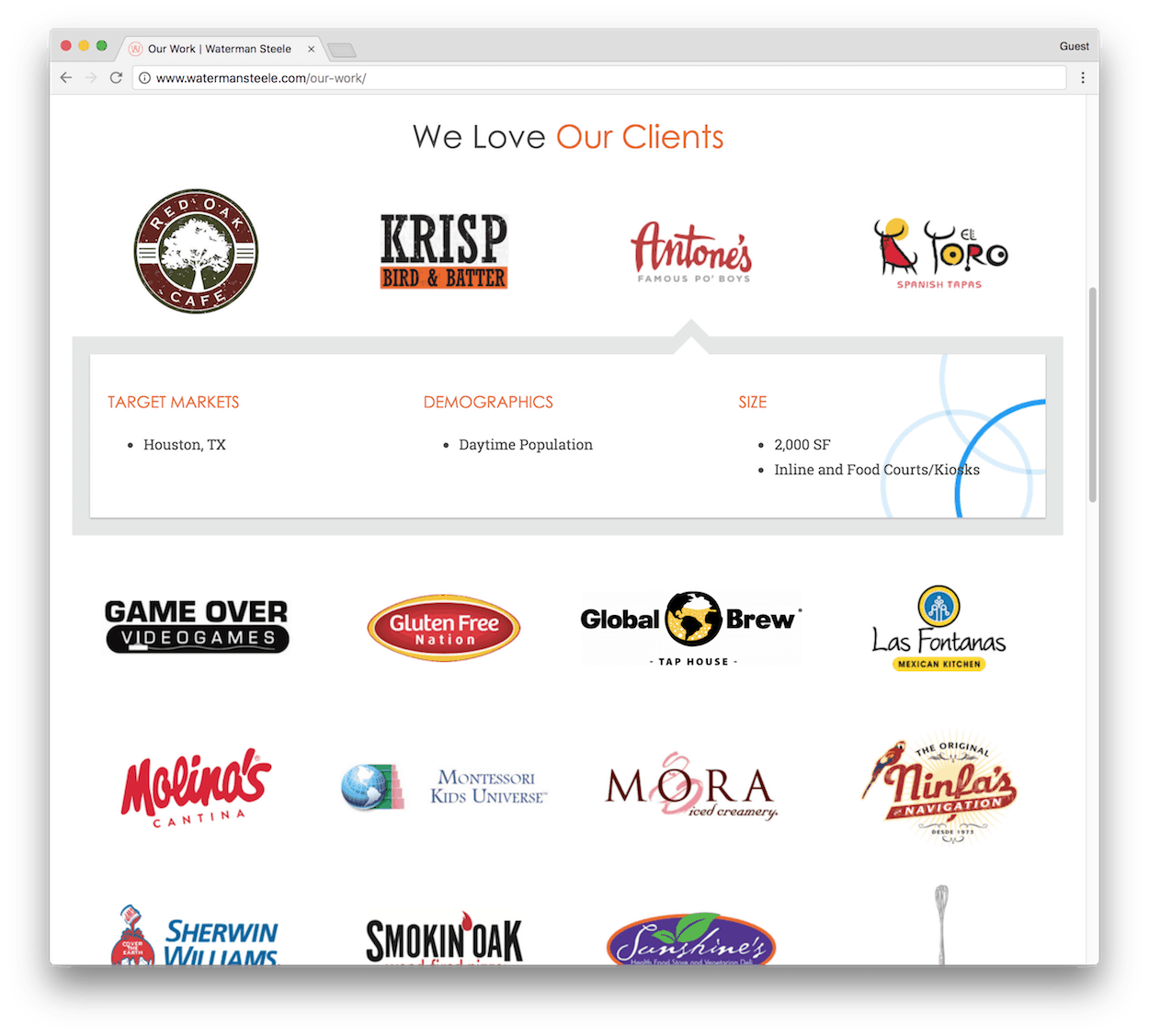
Show Your Work
When trying to prove the credibility of your company, showing your work is crucial. You can do this through simple project photos and descriptions or full case studies that provide more particulars for each project. Either way, your portfolio or case studies (or both!) will help the prospect connect your past project experience with their current need.
Another helpful tip here: prospects are interested both in what you do and how you do what you do. Think of your math teacher. It’s helpful to show your work.
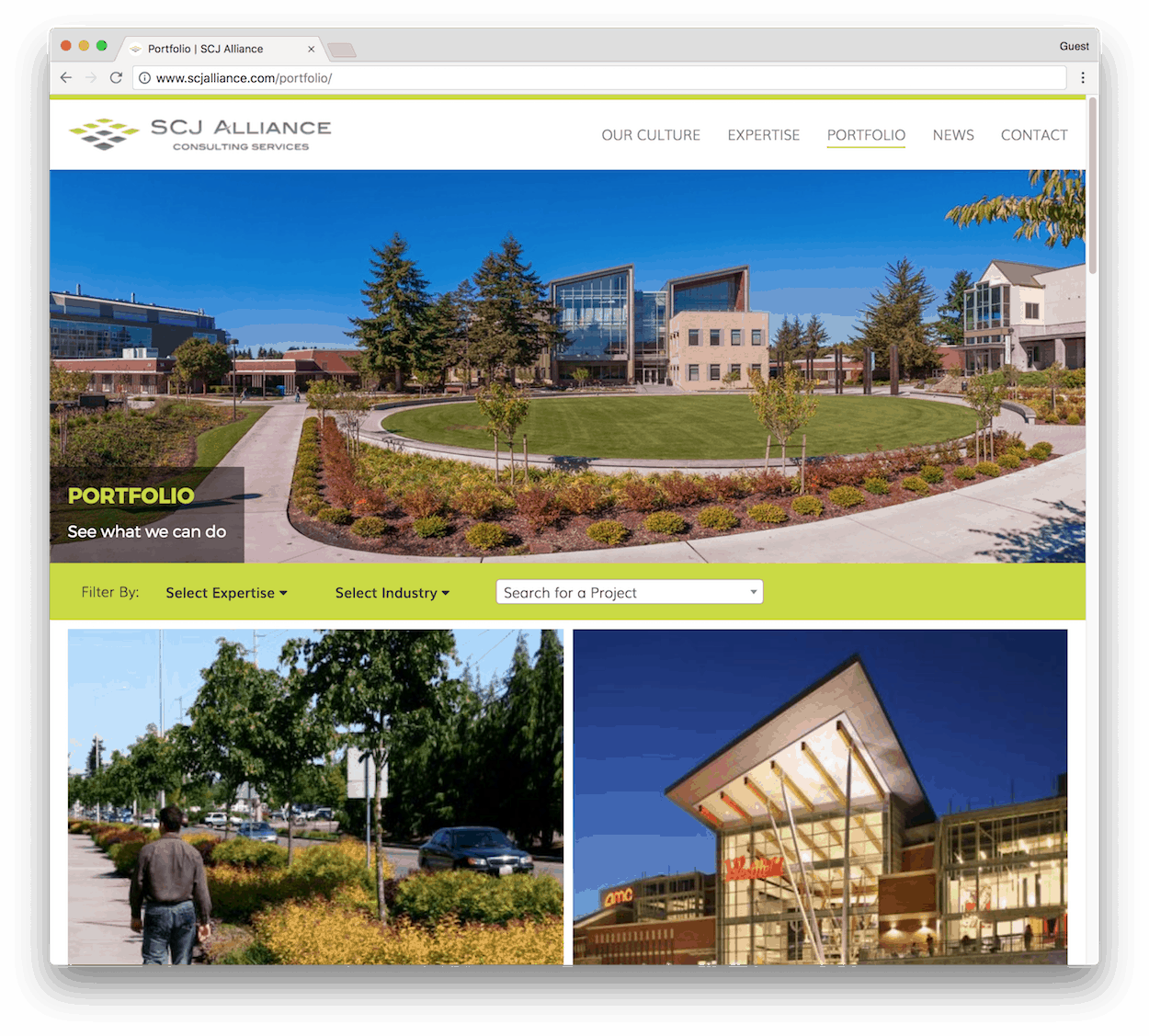
Include Client Testimonials
It’s one thing to post a company’s logo on your client page. It’s a whole ‘nother thing if that client actually enjoyed working with your construction company.
When considering which testimonials to post on your website, keep these pointers in mind:
- The best testimonials are specific – consider these two testimonials:
- Vague: “John Mark Construction did a great job on my project and I’m really happy with their work.”
- Specific: “John Mark Construction did a fantastic job on our new commercial building. They never cut corners, are always on time and all of their employees are super respectful. We couldn’t have made a better choice.”
- Use full information – such as full name and company name. This will bring validity to your testimonials. Anyone can write fake testimonials, but if you’re using real people at real companies, your prospects will feel more at ease.
- Use photos – if possible, use headshot photos of your clients. This will make your testimonials more interesting and personal.
[blog_important text=”Make sure to double check with past clients before posting their testimonial on your website. Some companies restrict what employees can and can’t say about vendors.”]
Tip #4: Have Clear Service Pages
It’s as simple as this. If prospect thinks you don’t do a particular service, there’s little chance that they’re going to reach out to you from your website. Be clear about what services you provide by writing out individual service pages for each one. You can go into more detail on these individual pages and get into the how of your work.
Additionally, you should have a high-level services landing page where all of your services are listed. You should also be linking to this page from your header navigation and your homepage. Here are a few more tips:
- Consider building contact forms directly into your services pages. Then if a client is interested, they can easily fill out the form.
- Use icons to make services and sub-services more scannable.
- Include related projects and staff members on your service pages to make them more engaging.
- Consider related blog posts and resources on your services pages.
[blog_share]
Tip #5: Don’t Go Cheap on Photos
Yes, I get it. I own a business myself. Business is expensive. Why spend an arm and a leg on photos for your website?
Well, remember what I said about attributes from your website reflecting on your company? It’s very possible for cheap photos to make your company look cheap. For example, consider these two screenshots for staff photos. Which one is more appealing?
Example 1:

Example 2:

Clearly, the photos for the second example are superior.
- All of the backgrounds are consistent
- Everyone is dressed in matching attire
- The headshot sizes are the same
- All of the photos are high-quality.
Here’s another example from a project portfolio standpoint. How do you feel when you look at the images of these?
Example 1:
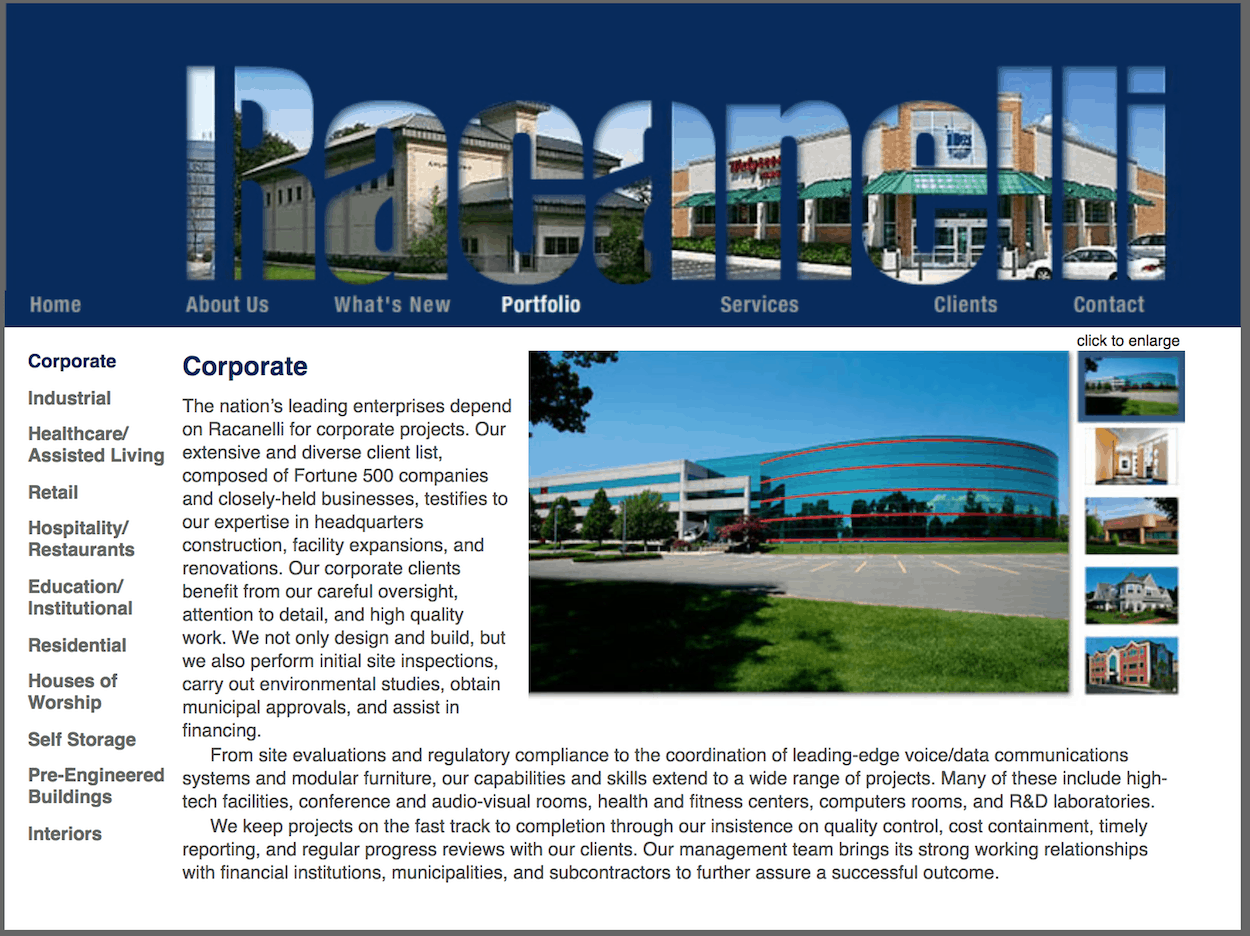
Example 2:
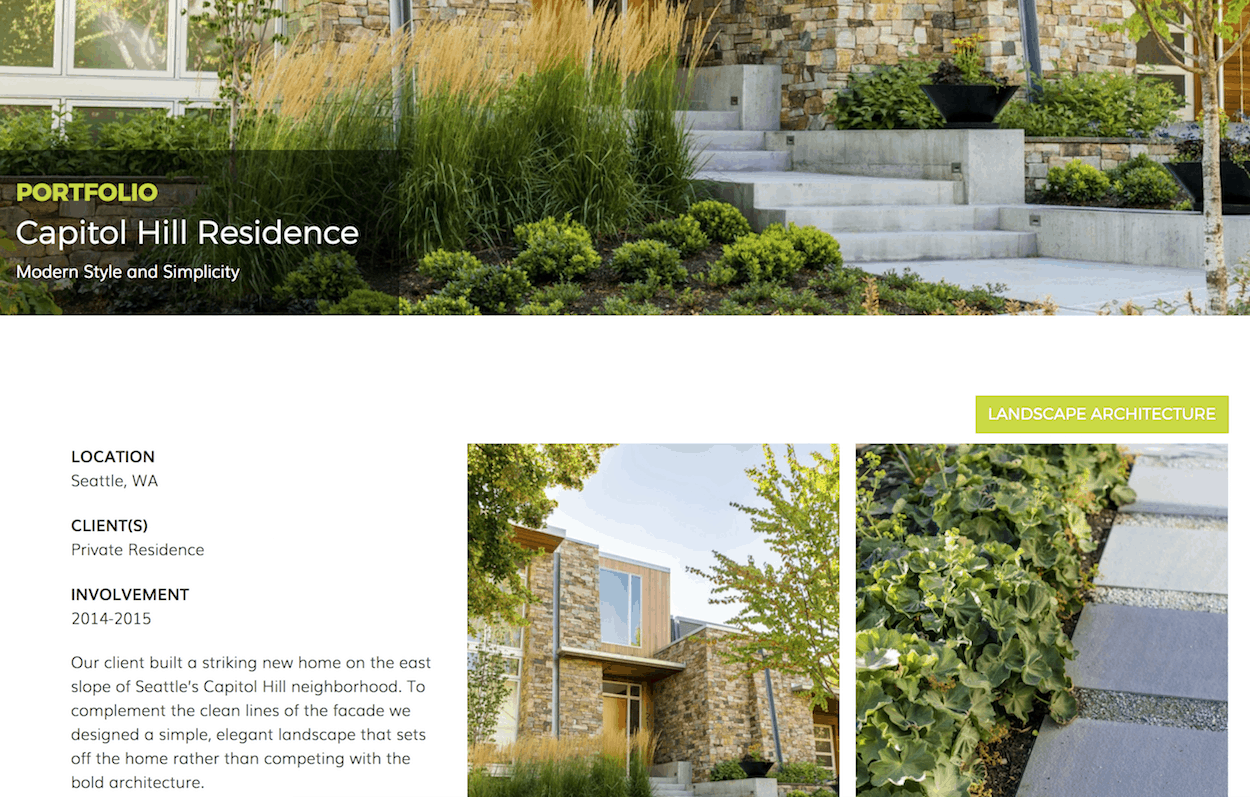
Do you see the difference that high-quality, high-resolution photos make? My goal here is not to poke fun at any companies in particular, but rather to point out that investing in good photos will make a huge difference.
[blog_callout text=”Investing in good photos will make a huge difference.”]
Tip #6: Be a Thought Leader
You have great ideas all the time. When you think about why a client should pick your construction company for their project, you can pinpoint exact reasons that will benefit them. When a client asks about a particular product or approach, you’re easily able to provide a solid answer. People thank you all the time for how much your advice has helped them.
There’s only one problem with all of your knowledge: you don’t share it on your website.
But understand me, this is a huge missed opportunity! Here a few benefits of providing free and helpful articles on your website (also called “Content Marketing”).
Brand Engagement
Let’s say that you’re an expert at commercial construction projects. You live, breath and drink commercial construction work. Well, what can you give away for free to your prospective clients regarding your passion? Here are a few ideas:
- Write a blog post called “How to Navigate a Commercial Construction Project without Losing Your Shirt”
- Create an ebook called “Commercial Construction: 10 Pitfalls”
- Create a video where you talk about the benefits of building a commercial property instead of buying an existing one
- Create a commercial construction project checklist
When you create helpful and free resources like this, you’re doing something special. You’re building a bridge between yourself and your prospect. You’re giving them a taste of what it’s like to work with your company and starting the journey of customer loyalty.
[blog_callout text=”You’re giving them a taste of what it’s like to work with your company and starting the journey of customer loyalty.”]
Soon enough, when they have a construction project that they need to bid out, who do they think of? Well, you, of course.
Search Engine Traffic
A second benefit of creating free content and resources is this: Google loves, loves, loves quality content. In some ways, the more the better. See, you thought you were just writing an article on your favorite siding product so that you could hand it out to existing customers or prospects. But what you didn’t anticipate was that Google and other search engines would index your website for a myriad of new keywords and phrases. Now all the sudden you’re showing up on Google for phrases like:
- “How to choose between siding brands”
- “Top siding products”
- “What color is best for siding”
- “Can siding come pre-painted?”
Sure, for some of these you’re on page 5, 6, 7… but the point here is that you start getting traffic, even if it just a little bit, to your website. The more you create helpful and quality resources, the more Google starts to trust your brand and the more Google will send you traffic.
[blog_related url=”https://www.jordancrown.com/blog/4-tips-for-making-your-website-seo-friendly/” label=”4 Tips for Making Your Website SEO Friendly”]
Unintended Consequences
When you decide that you’re going to simply put valuable content out on your website, there is a flurry of unintended, positive consequences. Here a few of them to get you excited:
- Your content starts getting picked up by other sources and thought leaders
- You start getting requests for interviews and guest blogs
- Your content could go viral on social networks
- You get better and better at writing so your ability to crank stuff out gets faster and faster
- You get the reward of website visitors thanking you for valuable content
There’s so much to say here. There are so many rewards in giving away free resources. What’s the biggest challenge? Why aren’t you blogging yet? Well, the answer is simple. You don’t believe it works.
But let me challenge you, start writing 1 or 2 blog posts a week that will benefit your audience. Do for a few weeks and you may find that you enjoy it. Do it for a few months and you might find something that gives you even more incentive:
Leads, leads, leads.
Tip #7: Choose Your Niche
Another powerful tactic when it comes to construction leads is getting clear on who your market is and who your market isn’t. Here’s a story for you:
…
George owns a 20 person construction company. They do fine work but George always has the looming burden over his head that he could run out of work, and then he’d have to fire half of his team. Consequently, because of George’s stress, he feels like he can’t say no to any prospective project. To make things worse, sometimes he says yes to projects that actually lose him money and hurt his brand.
George doesn’t know who his market is, so he always struggles to make a solid pitch in his sales meetings. Because he’s willing to serve anyone, he can’t speak intelligently about any industries or services in particular. Instead, he’s forced to used weak generalizations in his sales meetings.
It’s not unusual for George to daydream about selling his company and getting a traditional job where he’s doesn’t feel constantly drained.
…
Does this sound familiar?
George’s biggest issue is that he’s refusing to define his customer. But when you define your customer, you actually have something useful to say. And when you have something useful to say… folks find you compelling. And when they find you compelling… well, you guessed it, they want to work with you.
[blog_callout text=”When you define your customer, you actually have something useful to say.”]
Along with getting more leads, defining your target market also helps you with the following:
- Content create – finally, you can begin to talk to your audience because you know who they are
- Expertise – because you’re speaking your market’s language, they see you as an expert
- Customer retention – when you’re the expert with someone’s industry, it’s easier for them to come back to you over and over
As an example, a few of the niche markets that we serve include construction and engineering firms, consultants, home builders and building material companies.
Take a moment to open some of these links. Can you see how specifically we’re able to talk to each of these markets on these pages?
Tip #8: Talk About the “How”
I can tell you that my company is really good at new home construction. I might be able to prove our worth by talking to you about the homes we’ve built, the strength of our team or the years that we’ve been in business.
But if I really want to get your mouth watering, I should tell you the “how” in what we do.
Talking about the “how” of your business exposes a lot of underlying principals and standards in the way that you work. Your prospective customer wants confidence in your abilities, so one of the best ways to build confidence is to show them how you do things.
[blog_callout text=”One of the best ways to build customer confidence is to show them how you do things.”]
With our home building example, here are some ways you can talk about the “how”.
Show Your Prospect a Sample Project Schedule
Let them see real plans and milestones for a real project on your website. This will allow the prospect to imagine what it’s like to actually work with you. They can envision how their project might pan out based on the level of detail you provide in your planning process.
Bake Your Process into Your Case Studies
People love stories. And case studies are, for the most part, stories with key goals and outcomes. As you’re describing how you’ve helped another client win, weave your process into the story. Tell them specifics on how you handled certain situations and pitfalls.
Spill Your Secret Sauce on Your Website
Ok, well, don’t share everything. But, getting into the weeds a bit on a “process” page will help wet your prospect’s appetite. Helping them see underneath the engine for a few moments on your website may give them the confidence they need to start a conversation.
Bottom line in all of this? Share some of your how, and don’t be surprised when you get an uptick of leads. As a bonus, these leads already understand your process so they’re much easier to work with.
Conclusion
When it comes to marketing, it’s important to keep the analogy of farming in mind. When a farmer does his work, he’s not certain how much of a crop it is that he’ll yield, but nevertheless, he puts in the work. Additionally, he knows that if he doesn’t get to work, he can be assured of this: he won’t have a crop at all.
In marketing, the goal is to plant seeds and continually be nourishing your different crops. Sometimes you’ll experiment and you won’t get much of a yield. Other times, you’ll strike gold right away (yes, I know I’m mixing analogies at this point!). Bottom line: Invest in these 4 areas of your construction website and you’ll be giving your prospects a lot more incentive to contact you.
[blog_subscribe]